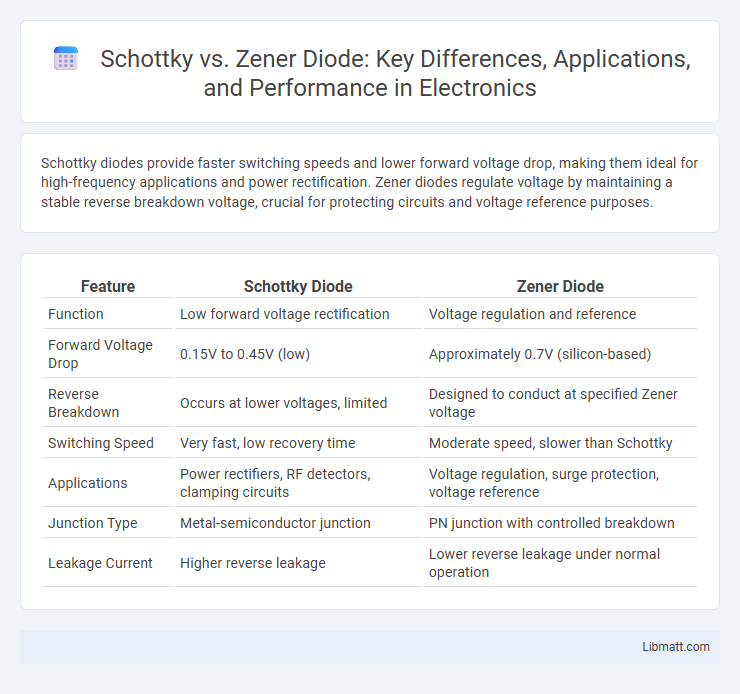Schottky diodes provide faster switching speeds and lower forward voltage drop, making them ideal for high-frequency applications and power rectification. Zener diodes regulate voltage by maintaining a stable reverse breakdown voltage, crucial for protecting circuits and voltage reference purposes.
Table of Comparison
| Feature | Schottky Diode | Zener Diode |
|---|---|---|
| Function | Low forward voltage rectification | Voltage regulation and reference |
| Forward Voltage Drop | 0.15V to 0.45V (low) | Approximately 0.7V (silicon-based) |
| Reverse Breakdown | Occurs at lower voltages, limited | Designed to conduct at specified Zener voltage |
| Switching Speed | Very fast, low recovery time | Moderate speed, slower than Schottky |
| Applications | Power rectifiers, RF detectors, clamping circuits | Voltage regulation, surge protection, voltage reference |
| Junction Type | Metal-semiconductor junction | PN junction with controlled breakdown |
| Leakage Current | Higher reverse leakage | Lower reverse leakage under normal operation |
Introduction to Schottky and Zener Diodes
Schottky diodes are semiconductor devices characterized by their low forward voltage drop and fast switching speed, commonly used in power rectification and RF applications. Zener diodes are designed to allow current to flow in the reverse direction when a specific breakdown voltage is reached, making them essential for voltage regulation and protection circuits. Both diodes serve distinct functions, with Schottky diodes optimizing efficiency and switching performance, while Zener diodes ensure voltage stability and circuit protection.
Basic Working Principles
Schottky diodes operate using a metal-semiconductor junction that enables fast switching and low forward voltage drop, making them efficient for high-speed rectification. Zener diodes function based on reverse breakdown voltage, allowing them to regulate voltage by maintaining a stable reference voltage when reverse biased beyond their specified threshold. The distinct mechanisms enable Schottky diodes to excel in power efficiency and switching applications, while Zener diodes provide precise voltage regulation and protection in electronic circuits.
Construction and Material Differences
Schottky diodes are constructed using a metal-semiconductor junction, typically involving materials like platinum, chromium, or tungsten in contact with n-type silicon, resulting in low forward voltage drop and fast switching speed. Zener diodes, on the other hand, are made from heavily doped p-n semiconductor junctions, primarily using silicon, designed to reliably operate in reverse breakdown mode at precise voltage levels. Understanding these material and construction differences helps you select the appropriate diode based on switching characteristics and voltage regulation needs.
Voltage-Current Characteristics
Schottky diodes exhibit a low forward voltage drop typically between 0.2 to 0.3 volts, enabling faster switching speeds and minimal power loss, which contrasts with Zener diodes that are designed to operate in reverse breakdown region with a precise breakdown voltage used for voltage regulation. The current-voltage characteristic of a Schottky diode shows a sharp rise in forward current with a small increase in forward voltage, while Zener diodes maintain a stable reverse voltage over a wide current range after reaching the breakdown voltage. Understanding these distinctions in voltage-current behavior helps optimize Your circuit design for efficiency or voltage stabilization purposes.
Key Applications of Schottky Diode
Schottky diodes are widely used in power rectification, voltage clamping, and high-frequency switching due to their low forward voltage drop and fast recovery time. They enhance efficiency in power supplies and solar cells by minimizing energy loss and heat generation. Your designs benefit from Schottky diodes when rapid response and reduced voltage drop are critical in circuits such as RF applications and DC-DC converters.
Key Applications of Zener Diode
Zener diodes are primarily used for voltage regulation, providing a stable reference voltage in power supplies and protecting circuits from overvoltage conditions. Their ability to maintain a constant voltage across varying currents makes them ideal for surge protectors, voltage clamping, and voltage reference in measurement instruments. You can rely on Zener diodes to ensure consistent performance in electronic devices where precise voltage control is essential.
Efficiency and Power Loss Comparison
Schottky diodes exhibit higher efficiency and lower power loss due to their low forward voltage drop, typically around 0.2 to 0.3 volts, which reduces heat generation in high-speed switching applications. Zener diodes, on the other hand, primarily function in voltage regulation and experience higher power dissipation because they operate in reverse breakdown, causing greater energy loss under continuous conduction. Your choice between these diodes should consider the efficiency demands and power loss constraints specific to your electronic circuit design.
Reverse Recovery Time and Switching Speed
Schottky diodes exhibit significantly faster switching speeds and shorter reverse recovery times compared to Zener diodes, due to their majority carrier conduction mechanism, making them ideal for high-frequency applications. Zener diodes, designed primarily for voltage regulation and voltage reference, have longer reverse recovery times as they operate under avalanche breakdown conditions, which slows down switching performance. Your choice between these diodes should consider the required switching speed and efficiency, with Schottky diodes preferred for rapid switching circuits and Zener diodes for voltage stabilization tasks.
Cost, Availability, and Reliability
Schottky diodes generally have a higher cost compared to Zener diodes due to their metal-semiconductor junction and faster switching capabilities, yet they remain widely available in various voltage and current ratings for power applications. Zener diodes are typically more cost-effective and easily sourced, especially for voltage regulation and reference use, making them a preferred choice in budget-conscious designs. In terms of reliability, Schottky diodes offer superior performance in low forward voltage drop and high-speed switching, but Zener diodes provide robust, stable voltage regulation in diverse environmental conditions, enhancing their long-term dependability.
Choosing Between Schottky and Zener Diodes
Choosing between Schottky and Zener diodes depends on the specific application requirements such as voltage regulation, reverse current leakage, and switching speed. Schottky diodes offer low forward voltage drop and fast switching, making them ideal for power rectification and high-frequency circuits, while Zener diodes provide precise voltage regulation and over-voltage protection in low-power applications. Factors like maximum reverse voltage, leakage current, and thermal stability must be considered to select the appropriate diode for reliable circuit performance.
Schottky vs Zener Diode Infographic

 libmatt.com
libmatt.com